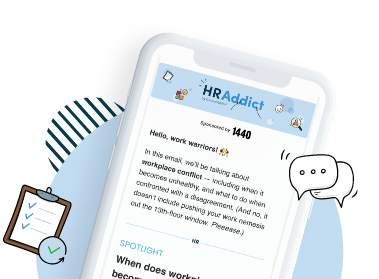Whether you have you’re a small business owner or are the director of a large corporation, having an employee handbook is a must. An employee handbook not only outlines a consistent set of employee expectations, rules, and behaviors, but can also provide legal protections for the employer as well.
However, while an employee handbook is a valuable resource for both employers and employees alike, creating one can be a daunting task. But no need to fret! In this comprehensive guide, we cover everything you need to know to get started creating your own employee handbook.
What is an employee handbook?
An employee handbook, also known as a staff manual, is a document that companies typically issue to new employees during the onboarding process when a candidate has completed a successful job interview and has received their offer letter. Employee handbooks can be a highly valuable resource when hiring new employees, but also for veteran employees as well. Because they contain information on company policies, expectations, employee benefits and the company code of conduct, they are a useful source of information for employees during the entire duration of their time with the company.
In terms of knowledge management within a company, employee handbooks are considered best practice for ensuring that all employees have access to consistent and accurate company information. In terms of format, employee handbooks can be in the form of a physical document, slide deck, or digital PDF. They are also often written and designed to reflect the brand and culture of the company.
Why you need an employee handbook
There are various advantages to having an employee handbook. One of the main advantages is that it ensures the employer is legally protected. While an employee handbook is often not a legal requirement, there may be some contents included in the handbook that are required by local or national employment laws. Depending on where you live, you may be required to provide employees with a written document outlining certain information, such as disciplinary policies or their rights as an employee.
However, aside from the legal aspects, an employee handbook also makes employees aware of expectations, applies consistent rules and establishes behavioral norms, which all contribute to an improved employee experience. Since employees already have access to this information, it also reduces the amount of queries directed to the HR department, which contributes to a culture of efficiency.
What to include
Now that we’ve covered what an employee handbook is and why it is so important to have one, we’ll dive into what exactly an employee handbook should contain. Although each company’s employee handbook will vary to some degree, there are best practices in terms of which sections and types of information you should include. Below are six sections that are beneficial to include in an employee handbook:
1. Welcome statement
First impressions matter — particularly when you want to make a good impression on new hires during onboarding. And a welcome statement in your employee handbook is a great way to do just that. While a welcome statement is not mandatory, it is a personal touch that can contribute to new hires feeling warmly greeted and welcomed at their new workplace.
A welcome statement or welcome letter is a message that is usually placed at the beginning of the employee handbook. Oftentimes, the CEO or company founder will write the welcome letter. However, the welcome statement could be a general message from the entire company as well.
The purpose of the welcome statement is to foster in new employees a sense of belonging in the company. The content of the welcome statement will usually include expressions of enthusiasm about the new hires and wish them success during their time with the company.
2. Company introduction
As the employee handbook is often used to onboard new employees, it’s important to include a company introduction section that includes general information. This helps new hires get better acquainted with the company and understand the larger context of their role within the organization.
However, the company introduction doesn’t only help new employees familiarize themselves with the facts about the organization, but also enables them to better understand the company values, mission and overall culture. And when employees are aligned with the company culture, this can contribute to higher levels of engagement and employee satisfaction.
The company introduction will usually contain information such as the company’s history, mission statement, vision and values. However, it could also contain more practical information, such as company locations and employees’ access to buildings.
3. Policies and procedures
One of the core elements of an employee handbook is the company’s policies and procedures section, which will in many cases take up the largest portion of the document.
This section typically includes information about the hiring process and candidate selection procedures, employee rights that are protected by law, such as policies around harassment, violence, weapons, safe working conditions, and discrimination, such as racism. However, it often will also include information on working hours, disciplinary procedures and termination, employee monitoring policies and communication policies, such as an open door policy.
When creating company policies and procedures, it’s important to ensure that they are in line with national, state and local employment laws. Therefore, it’s advised to have this section reviewed by legal counsel or HR experts in employment law.
4. Code of conduct
The code of conduct section of an employee handbook outlines how employees are expected to behave at work and defines which type of behavior is acceptable. This section is typically largely influenced by the overall company culture.
Some examples of types of information that are included in the code of conduct are dress code, use of technologies like social media, use of company email, and what constitutes as a conflict of interest.
As companies vary in terms of ways of working, the code of conduct section may also stipulate flexible or remote working arrangements. With the advent of many companies, such as Google and Amazon, permitting employees to bring pets to work, pet policies should also be included in the code of conduct.
5. Compensation and benefits
It is important to make new hires aware of what types of employee benefits they are entitled to. This not only ensures transparency up front but increases the probability that employees will actually utilize company benefits.
The compensation and benefits section of the employee handbook should include basic information on public holidays and leave entitlement. The various types of leave, such as annual leave, parental leave, compassionate leave, and sick leave, should be defined.
If the company provides any additional benefits, such as educational reimbursement, a company car or stock offerings, this information should be included in the compensation and benefits section as well.
6. Acknowledgement of receipt
An acknowledgement of receipt is a document that employees sign to confirm that they have received a copy of the employee handbook. Depending on where you live, you may be required by law to furnish employees certain information. Therefore, it’s important to check with your legal team as to whether this is the case prior to distributing the employee handbook.
However, even if there is no legal requirement to provide employees with any contents within the employee handbook, it is still good practice to ensure that employees sign an acknowledgment that they have received the employee handbook. If a dispute were to arise between an employer and employee, the acknowledgement of receipt is evidence that the employee was made aware of the company rules, policies and procedures.
Tips for creating an employee handbook
Since an employee handbook is such a valuable company resource, you’ll want to make sure that yours ticks all the boxes and serves the intended purpose. However, if you’re new to creating one, it can be difficult to know which pitfalls to look out for. For this reason, we’ve compiled five tips below to help you craft your employee handbook.
1. Review existing company policies
Even if your company doesn’t yet have an employee handbook, you most likely already have some existing policies. So, an important aspect of creating your employee handbook will be to review all existing policies to determine if they are relevant, beneficial and legal.
Policies are not set in stone and may need to be changed as the company grows and evolves. Once you create the initial employee handbook, it’s good practice to review and update it on an annual basis.
2. Keep it clear and engaging
Since the onboarding of new hires typically involves extensive reading and training, the last thing you’ll want to do is overwhelm new hires with an obscure employee handbook. Therefore, it’s important to ensure the employee handbook is as clear and engaging as possible.
However, the purpose of a clear and engaging employee handbook isn’t only to improve the experience for new hires, but also to help them to better find and retain important information that will help them in their role.
3. Know the laws
One of the most critical steps in creating an employee handbook is to be familiar with national and regional employment and labor laws, which may require seeking counsel from a legal or HR specialist.
However, writing your employee handbook in-line with laws does not mean you to need to create a legal document, per se. The policies should be written in a clear, concise way that doesn’t include superfluous legal information or jargon.
4. Stay on brand
The employee handbook is often one of the first impressions that new hires have of their company. Therefore, you’ll want to make sure that it is representative of your overall brand and culture.
For example, if your company is a creative, passion-driven startup that encourages questioning the status-quo, then a formal and rigid employee handbook is most likely not the impression you’ll want to send to new hires. So, make sure that the font, color choice and tone of voice are all reflective of the company brand and culture.
5. Don’t overlook culture
Many companies make the mistake of using the employee handbook strictly for liability purposes. However, the employee handbook should be more than a list of formal policies. It can also be used as a guideline that supports new employees with adapting to the overall culture.
Make sure to also include information that could help your employees better integrate. If employees tend to wear hoodies and sneakers to work, this could be helpful to mention so that new hires don’t feel out of place showing up to work in a suit and tie.
Employee handbook template
The information that should be included in an employee handbook varies substantially by company and location. Depending on where the company is located, some information may be required by law.
Certain information, such as company vehicle policies, may also not be relevant depending on the type of company and nature of business. However, when creating your own unique employee handbook, it can be highly beneficial to draw inspiration from others.
Below we’ve included a downloadable example outline to help you craft your own unique employee handbook.
Key takeaways
With the above information, you should now have a solid foundation to begin creating your own employee handbook. Before you start, it’s important to keep some tips in mind:
- Make sure the handbook is clear and engaging, so it’s easy for employees to read.
- Know your national, state and local employment laws in advance of creating any policies.
- Ensure that the visuals and tone of voice are on brand, as the handbook represents your company.
An employee handbook is one of the best ways to ensure new hires start their time at your company off on a good foot. However, it not only gives employees the best chance of success, but the entire company as a whole.
Is there anything you’ve added into your employee handbook that we’ve missed? Let us know in the comments!
This article was originally published back in 2017.

